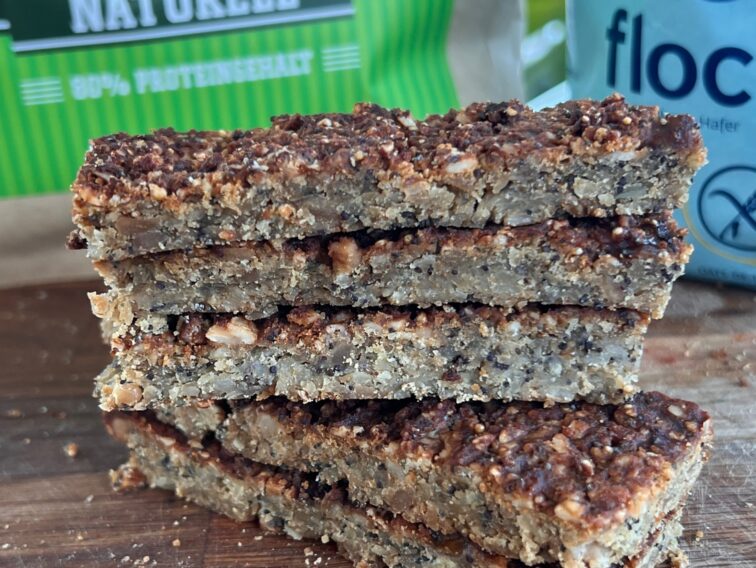Protein is extremely important for healing the body. It helps repair organ tissue, build new cells, make antibodies, maintain cell health, stabilize blood sugar, balance hormones and reduce inflammation if consumed correctly. That means not having too little or too much.
Vegans, vegetarians and people who avoid meat or protein because they think it’s unhealthy, may struggle with enough strength to fuel the healing process.
To properly digest animal protein, if you have low stomach acid, you may need strong stomach acid support (HCL or bitters) or simply to cook the meat till it’s very soft and/or blend the protein into soups for easier absorption.
Below I will also cover what are good sources of protein and how much you need.
And because people with weak digestion may not be able to eat a lot of protein in one sitting, I’ve included a recipe for protein bars that make a great snack.
Protein helps keep blood sugar stable, which is key for lowering inflammation and balancing cortisol. Unstable blood sugar spikes cortisol, which increases inflammation and breaks down the gut lining (not great if you already have a leaky gut).
High cortisol can be a leading cause of hormonal imbalances also. So eating adequate protein supports hormonal balance too.
Other benefits of protein is building muscle. This is particularly important if you are in your 40s, 50s and beyond. Muscle helps keep us young, strong and mobile. It’s the key to ageing well.
As an animal lover, I feel guilty eating animal protein. I try to buy pastured and grass fed meat to support better animal raising and reduce toxins. If an animal is full of growth hormones, antibiotics and stress hormones, you will be too.
Best sources of protein
Plant sources of protein include nuts, seeds, beans, soy and grains. Often they are hard to digest due to fiber content and can be tough on the gut lining due to lectins. With animal protein you need to eat less to get more protein and it’s easier to convert meat into amino acids in your body.
Consuming animal protein is best for protein. Cooking it in a slow cooker or pressure cooker will break the proteins in the meat down and make it easier to digest.
Red meat gets a bad rap but it’s full of immune-building zinc, iron and B12, which are essential for good gut health and healthy stomach acid.
I ate a lot of red meat while healing from IBS. I used HCL (hydrochloric acid) capsules for the first two weeks to help me digest it.
Last year, I tried to eat a primarily vegetarian diet and gained weight, had less energy and felt a lot worse. My vegetarian experiment was a good reminder of why I need meat.
How much protein do you need?
The general rule of thumb with protein is that we need about .8 grams per kilo or .36 grams per pound of body weight for younger and less active people.
If you are active and over 45, your requirements increases to 1.5 grams per kilo or .7 grams per pound of body weight.
That means at 120 pounds I need to consume 84 grams of protein daily. That’s a lot. Be cautious of overdoing protein. More than 30 grams per meal may turn into sugar in your body. When you overdose on protein your liver turns it into sugar. This is the opposite of what we want.
If you want to consume 25 grams of protein in one meal that would equal 3 ounces of chicken breast. There are many phone apps that will help you measure the carbs, protein and fat in your meals.
Supplementing with protein powder between meals is a good way to get your daily quota. My favorite protein powder is pea protein. It’s one of the best tolerated. Whey protein (from milk) has more protein but is not as well tolerated.
You can add a scoop of pea protein to a smoothie or mix it into yogurt. I add a bit of nut or seed butter and a mashed banana for healthy treat.
You can also bake with pea protein (see my recipe for homemade protein bars below).
Spreading protein consumption throughout the day is the best way to avoid overwhelming your body in one sitting.
Note: If you have SIBO, snacking may be discouraged, so you can eat these protein bars for breakfast. And because they’re vegan, you can eat the dough raw if you don’t want to bake it.
While what you eat is important, how you eat is just as important.
Because protein is hard to digest, lower stress with deep breathing before eating, take apple cider vinegar, bitter or an HCL capsule if you’re eating a high protein meal.
Work on stomach acid by regulating the nervous system issues or addressing h. pylori.
Try to keep it simple, without overthinking it. Including protein in each meal in the form of meat, yogurt, nuts, cheese or beans if you tolerate them.
These protein bars feature some of the highest sources of vegetarian protein and can be eaten raw or baked because they are egg free. You are welcome to add an egg if you want to up the protein content.
Homemade high protein bars

This recipes yields a total of 145 grams of protein. Eat it with Greek yogurt for more protein.
Commercial protein bars are high in sugar or sugar alcohols, and contain chemicals, gums, fillers and preservatives to make them shelf stable. These ingredients can gum up digestion.
Not only are these bars natural and full of protein, but they also contain resistant starch and safe, soluble fiber. Use gluten free oats if you’re sensitive to gluten. (I did).
Use your fav nut or seed butter (or coconut butter if you are sensitive to nuts or seeds). Customize this to your taste.
This clean, protein-rich snack will feed beneficial bacteria, build muscle, balance blood sugar and reduce inflammation without breaking the bank.
If you want more higher protein and low carb treats that are grain-free, check out my Treats That Heal cookbook bundle.
Protein cookie recipe
¾ cup of gluten free oats 7.5 grams of protein
¾ cup of pea protein powder 84 grams of protein
2 Tablespoons of chia seeds 6 grams
¾ cup of nut or seed butter of choice 38 grams
Optional: ¾ cup of puffed quinoa or amaranth or rice 9 grams
2 Tablespoons of coconut oil 0 grams
Optional: 2 Tablespoons of flax seeds 3 grams
1 banana 1.3 grams
1 teaspoon or Tablespoon of honey 0 grams
Enough non-dairy milk to give it a pancake batter consistency so it’s easy to mix by hand
Mix all ingredients in a bowl by hand or put it in a mixer or food processor for a smoother batter.
Pour into a brownie pan and bake at 375 for 25 to 30 minutes, checking on it to make sure it doesn’t burn.
When it browns on the top it is very close to ready.


